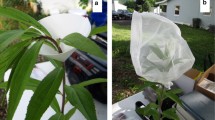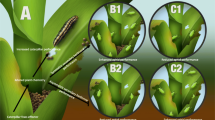Abstract
In the goldenrod Solidago altissima, most stems are erect, but “ducking” genotypes bend the tip of the apical stem downward for much of the growing season, and this morphology protects against at least two gall-forming herbivore species. Despite this advantage to defense, ducking remains a rare strategy in goldenrod, yet the costs that prevent ducking genotypes from outcompeting erect genotypes remain unclear. We tested whether ducking (an architectural defense) trades off with chemical defense against aphids (Uroleucon nigrotuberculatum). We hypothesized that signaling related to the ducking defense might interfere with investment in chemical defenses, making ducking plants more susceptible to some herbivores. To test this hypothesis, we compared aphid survival and preference on ducking and erect genotypes. We also measured terpenoid concentration in S. altissima leaf tissue to determine whether plant investment in these compounds correlated with either ducking or aphid performance. Aphids had higher survival on all three ducking genotypes than their erect counterparts and preferred ducking to erect plants in two of three genotype pairings. However, terpenoid concentrations did not track with either ducking or aphid performance and cannot therefore explain the differences between ducking and erect host-plants. Although the mechanism remains unknown, the data supported the predicted trade-off in defenses against different herbivores, which may contribute to the distribution and abundance of these two defensive strategies.




Similar content being viewed by others
References
Alba C, Bowers MD, Blumenthal D, Hufbauer R (2011) Evolution of growth but not structural or chemical defense in Verbascum Thapsus (common mullein) following introduction to North America. Biol Invasions 13:2379–2389
Ballaré CL (2014) Light regulation of plant defense. Annu Rev Plant Biol 65:335–363
Cappuccino N (1988) Spatial patterns of goldenrod aphids and the response of enemies to patch density. Oecologia 76:607–610
Crankshaw DR, Langenheim JH (1981) Variation in terpenes and phenolics through leaf development in Hymenaea and its possible significance to herbivory. Biochem Syst Ecol 9:115–124
Francis F, Vandermoten S, Verheggen F, Lognay G, Haubruge E (2005) Is the (E)-β-farnesene only volatile terpenoid in aphids? J Appl Entomol 129:6–11
Gershenzon J (1994) Metabolic costs of terpenoid accumulation in higher plants. J Chem Ecol 20:1281–1328
Grunewald W, Vanholme B, Pauwels L, Plovie E, Inzé D, Gheysen G, Goossens A (2009) Expression of the Arabidopsis jasmonate signaling prepressor JAZ1/TIFY10A is stimulated by auxin. EMBO Rep 10:923–928
Gόmez NE, Witte L (2001) A simple method to extract essential oils form tissue samples by using microwave radiation. J Chem Ecol 27:2351–2359
Hagenbucher S, Wäckers FL, Wettstein FE, Olson DM, Ruberson JR, Romeis J (2013) Pest trade-offs in technology: reduced damage by caterpillars in Bt cottom benefits aphids. Proc R Soc B 280:20130042
Heath JJ, Kessler A, Woebbe E, Cipollini D, Stireman JO (2014) Exploring plant defense theory in tall goldenrod, Solidago altissima. New Phytol 202:1357–1370
Helms AM, De Moraes CM, Mescher MC, Tooker JF (2014) The volatile emission of Eurosta solidaginis primes herbivore-induced volatile production in Solidago altissima and does not directly deter insect feeding. BMC Plant Biol 14:173
Herms DA, Mattson WJ (1992) The dilemma of plants: to grow or defend. Q Reiv Biol 67:283–335
Huot B, Yao J, Montgomery BL, He SY (2014) Growth-defense tradeoffs in plants: a balancing act to optimize fitness. Mol Plant 7:1267–1287
Johnson RH, Hull-Sanders HM, Meyer GA (2007) Comparison of foliar terpenes between native and invasive Solidago gigantea. Biochem Syst Ecol 35:821–830
Kempel A, Schädler M, Chrobock T, Fischer M, van Kleunen M (2011) Tradeoffs associated with constitutive and induced plant resistance against herbivory. Proc Nat Acad Sci USA 108:5685–5689
Kim KS, Hill CB, Hartman GL, Mian MA, Diers BW (2008) Discovery of soybean aphid biotypes. Crop Sci 48:923–928
Koricheva J (2002) Meta-analysis of sources of variation in fitness costs. Ecology 83:176–190
Langeheim JH (1994) Higher plant terpenoids: a phytocentric overview of their ecological roles. J Chem Ecol 20:1223–1280
Levin DA (1973) The role of trichomes in plant defense. Q Rev Biol 48:3–15
Manninen A-M, Vuorinen M, Holopainen JK (1998) Variation in growth, chemical defense, and herbivore resistance in scots pine provenances. J Chem Ecol 24:1315–1331
Pierik R, Ballaré CL, Dicke M (2014) Ecology of plant volatiles: taking a plant community perspective. Plant Cell Environ 37:1845–1853
R Core Team (2013) R: A language and environment for statistical computing. R Foundation for Statistical Computing, Vienna, Austria. http://www.R-project.org/
Santner A, Calderon-Villalobos LIA, Estelle M (2009) Plant hormones are versatile chemical regulators of plant growth. Nat Chem Ecol 5:301–307
Smith CM, Boyko EV (2007) The molecular bases of plant resistance and defense responses to aphid feeding: current status. Entomol Exp Appl 122:1–16
Smith CM, Chuang W-P (2014) Plant resistance to aphid feeding: behavioral, physiological, genetic and molecular cues regulate aphid host selection and feeding. Pest Manag Sci 70:528–540
Stamp N (2003) Out of the quagmire of plant defense hypotheses. Q Rev Biol 78:23–55
Thaler JS, Humphrey PT, Whiteman NK (2012) Evolution of jasmonate and salicylate signal crosstalk. Trends Plant Sci 17:260–270
Unsicker SB, Kunert G, Gershenzon J (2009) Protective perfumes: the role of vegetative volatiles in plant defense against herbivores. Curr Opin Plant Biol 12:479–485
Walling LL (2008) Avoiding effective defenses: strategies employed by phloem-feeding insects. Plant Physiol 146:859–866
Wang Z, Song J, Han Z, Jiang Z, Zheng W, Chen J, Song Z, Shang S (2008) Quantitative structure-activity relationship of terpenoid aphid antifeedants. J Agric Food Chem 56:11361–11366
Williams RS, Avakian MA (2015) Colonization of Solidago altissima by the specialist aphid Uroleucon nigrotuberculatum: effects of genetic identity and leaf chemistry. J Chem Ecol 41:129–138
Wise MJ (2009) To duck or not to duck: resistance advantages and disadvantages of the candy-cane stem phenotype in tall goldenrod, Solidago altissima. New phytol 183:900–907
Wise MJ, Abrahamson WG (2008) Ducking as a means of resistance to herbivory in tall goldenrod, Solidago altissima. Ecology 89:3275–3281
Wise MJ, Abrahamson WG, Cole JA (2010a) The role of nodding stems in the goldenrod-gall-fly interaction: a test of the “ducking” hypothesis. Am J Bot 97:525–529
Wise MJ, Cole JA, Carr DE (2010b) A field study of potential ecological costs of resistance by ‘stem ducking’ in tall goldenrod, Solidago altissima. Entomol Exp App 136:271–280
Acknowledgements
We thank Andrew Aschwanden (The Pennsylvania State University, USA) for helping in maintaining plants. This work was supported in part by the Swiss National Science Foundation under Grant No. 31003A-163145, The David and Lucile Packard Foundation, and ETH Zürich, Switzerland, primarily through the salary of ECY. This work was also supported by the USDA National Institute of Food and Agriculture and Hatch Appropriations under Project #PEN04691 and Accession #1018545.
Author information
Authors and Affiliations
Corresponding author
Additional information
Publisher's Note
Springer Nature remains neutral with regard to jurisdictional claims in published maps and institutional affiliations.
Handling Editor: Dagmar Voigt.
Electronic supplementary material
Below is the link to the electronic supplementary material.
Rights and permissions
About this article
Cite this article
Yip, E.C., Sowers, R.P., Helms, A.M. et al. Trade-offs between defenses against herbivores in goldenrod (Solidago altissima). Arthropod-Plant Interactions 13, 279–287 (2019). https://doi.org/10.1007/s11829-019-09674-3
Received:
Accepted:
Published:
Issue Date:
DOI: https://doi.org/10.1007/s11829-019-09674-3




